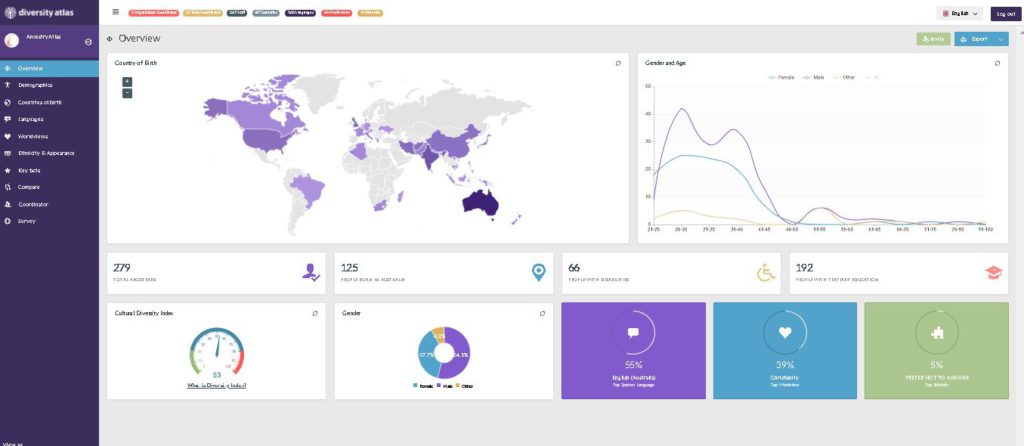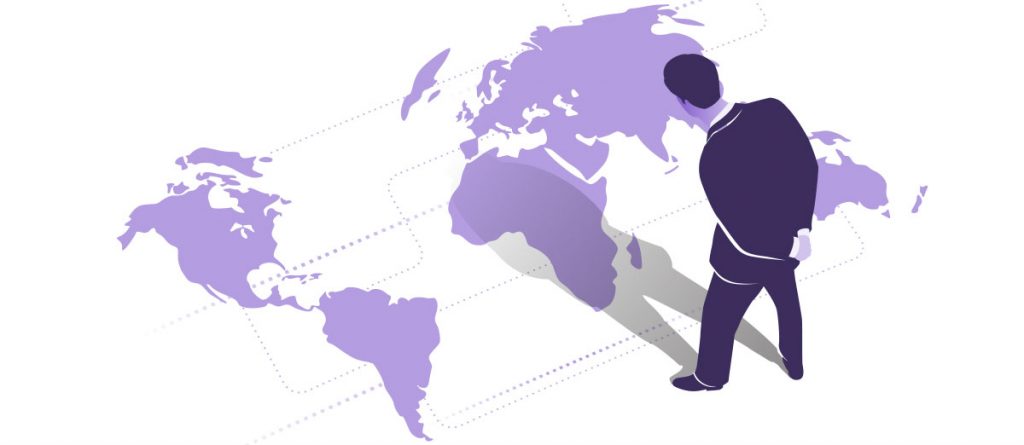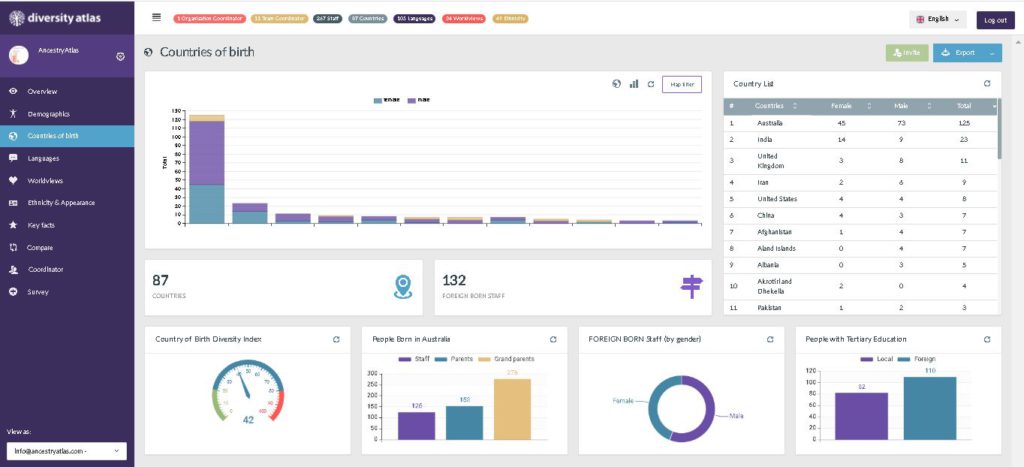
Discussions about the importance of cultural diversity are abundant in the professional literature and mainstream media. Despite intense interest, there is a significant knowledge gap in what is meant by diversity and how it can be measured. This article studies the importance of having an analytic approach to measure and benchmark cultural diversity. This measuring and benchmarking refer to a set of quantifiable dimensions of diversity that can be benchmarked, compared over time, evaluated against adjustable variables, and used as the basis for recommendations about improved business performance.
In other words, how data can be turned to valuable information, insight, and wisdom such as the DIKW model to encompass ideas and facts gained through an investigation, research, observation, study, and experience. An analytic approach can also involve the capacity to utilize this knowledge to a comprehensive scheme of life. Therefore, this article explores the significance of the DIKW model by describing reasons that support a data-driven approach to cultural diversity.
Making More Confident Decisions
Hunt, Prince, Dixon-Fyle, and Yee (2018), state that a data-driven approach to cultural diversity guarantees making confident decisions. For example, flow rate analytics allow companies to focus on specific levers where change would make a substantial effect over time. This process may involve the determination of promising female talent that businesses can nurture. Also, organizational leaders use data to decide specific areas of business that need exceptional intervention.
Incorporation of data when making decisions improve their impact (Anderson & Michael, 2017). In doing so, managerial confidence becomes more significant. Any business action for refining cultural diversity and inclusion must relate to set business strategy. The relationship facilitates determining the purpose of a business and key performance indicators.
The application of analytics enables sustainable improvement by selecting focus areas. Sources of information are employee opinion surveys, talent tracking for identified workers, evaluation of worker of attitudes, and high business potentials, and worker exit surveys. Reliance on data offers valuable insight for setting a competitive edge and an ongoing strategy for growth. A significant confident decision made cover hiring the right talent as described by Hunt, Prince, Dixon-Fyle, and Yee (2018), and illustrated below.
“A diverse and inclusive workplace is central to a company’s ability to attract, develop and retain the talent it needs to compete”
McKinsey Delivering through Diversity 2018
Employee interviews also confirm the importance of data for determining the degree of organizational cultural diversity and inclusion. The figure below shows employee response to the significance of cultural diversity in the global political setting. Bourke, Garr, van Berkel and Wong (2017), says that data help organizational leaders appreciate workforce complexity to initiate ways that ensure a competitive advantage. Learn more about how cultural diversity can help businesses thrive

Data-Driven Approach Guarantee Utilization of a Fact-Based Approach for Managing Diversity
A data-driven approach to increase organizational cultural diversity guarantees the utilization of a fact-based approach. According to Atewologun, Briner, and Cornish (2017), a fact-dependent managerial technique encompasses judicious, explicit, and conscientious dependence of four significant sources of information. Judiciousness warrants judging the quality or dependability of data to stress on using the most nuanced quality evidence. Explicit aspects necessitate communication of evidence openly and transparently ways to ensure proper assessment. Conscientiousness needs caution when gathering and using evidence. The first source of facts is scientific results from behavioral sciences and human resource (HR) literature. Research ensure applying evidence to encourage organization diversity (Nguyen, 2014).
Research findings offer valuable data concerning what work best for diversity training. Secondly, professional expertise from HR practitioners and diversity and inclusion provides useful facts. Evidence also arises from data available at the organizational level, including headcount, promotion data, and employee surveys (Atewologun, Briner & Cornish, 2017). Lastly, evidence arises from experience, concerns, and values of stakeholders such as clients, diversity champions, executive sponsors, worker resource networks, line managers, and customers.
Reliance on facts guarantees the use of varied sources of information to highlight and evaluate inclusion, bias, under-representation, feasible solutions, and exclusion to make informed decisions about initiatives planned. Therefore, a fact-based approach guarantees the utilization of a surefire method to manage diversity after considering the pros and cons of different available approaches.
Data-Drive Approach Encourage Setting Measurable Goals
The collection of organizational data is vital to examine change across different times and compare the performance of an organization with competitors (Pedulla, 2020). Goal-setting is a prerequisite for organizational success. It promotes inclusion, diversity, and equity (Pedulla, 2020). It involves various stages. The first stage is a company-based survey to pinpoint areas for diversity, improvement, and inclusion health of the corporation. Organizational surveyor applies insights to collect demographic data regarding race, ethnicity, disability, and gender.
The second stage is to determine groups, whether managers, departments, or leadership, to set useful targets. Group-based targets simplify pushing for accurate representation for all in an organization. Data analytics also help to decide demographics to represent. The process involved encompasses demographic structure reflection of the background of business operations. The use of demographics to set diversity targets guarantees the accomplishment of benefits expected. Fourthly, census information is a highly informative source of data and simplifies setting hiring targets that never discriminate against any ground. Organizational data on rates of recruitment and internal restructuring help in setting proper targets. The use of baseline and analysis data to set achievable targets for cultural diversity increases the possibility of organizational success.

Data-Driven Approach Simplifies Measuring Diversity Improvement over Time
V. Data enables the assessment of organizational advances of diversity over time. According to Berndtsson, Forsberg, Stein, and Svahn (2018), predictive and prescriptive analytics help organizational leaders determine and take advantage of emerging business insights. Data on the number of staff at an organization level according to their racial and ethnic composition guide decision-making that overlooks these backgrounds. Also, data on the staff titles and levels reveals gaps that must be fixed to increase organizational inclusivity. Areas for tracking progress on diversity include talent acquisition, pay rates, career advancement, and turnover. Organizational data contain information regarding attrition rates and hiring practices of employees.
Hiring data offers valuable insight into the diversity of selecting candidates to evaluate the strategy used for hiring. Consequently, the HR team would compare new hires who meet the term diversity to other hires who do not meet it to implement corrective measures (HR Daily Advisor, 2018). Career advancement statistics enable tracking promotion by different categories of diversity and job categories. Tracking diversity would portray how organizations treat staff and to meet categorization as an employer of choice.
Finding Data Patterns
The data-driven approach also enables finding useful patterns for cultural diversity. Such patterns help to avoid mistakes that arise when planning diversity efforts. Generally, organizational leaders strive to determine the intersectionality of different data (Wullert, Gilmartin & Simard, 2019). A diversity approach of one-size-fits-all usually benefits few workers, while a comprehensive alternative benefits the entire workforce. Several patterns of data display organizational performance. As such, HR leaders determine patterns of different data to avoid falling in the trap of faulty logic of a few numbers when structuring initiatives for diversity.

Help to Improve Performance of Business
Areas of tracking organizational performance such as talent acquisition, pay rates, career advancement, employee perception, and turnover are useful for identifying areas that require improvement (HR Daily Advisor, 2018). Generally, diversity is linked to gender, race, and ethnicity. HR personnel uses data analytics to broaden the organizational level of diversity to include age, religion, disability, and sexual orientation. Reliance on data facilitates the determination of cultural aspects that support businesses throughout their strategic expeditions. By and large, corporations explore prevailing cultural aspects in their extents of action to decide how cultural features resonate. Also, the examination process guide in making choices on whether cultural aspects make sense to a contradictory collective workforce of clients.
HR department collects factual data to cultivate a broad change management program that includes dissimilar cultures. Customized interventions classically have a considerable influence. Organizational HR staff apply data on employees to support businesses to upsurge the commitment of workers. Therefore, reliance on data guarantees the achievement of all goals for cultural diversity. Read how organizations can collect better sexual orientation data to achieve a more inclusive workplace.
Conclusion
The business case for diverse workplaces continues to gain universal relevance. A data-driven approach is an effective way to achieve a culturally diverse workforce. Crafting a functional diversity and inclusion method is involving and demand an inclusive, robust, and sustained leadership. Data simplifies the evaluation of workforce complexity. The importance of a data-driven approach to diversity covered in this article would help organizational leaders make informed decisions.
References
Anderson, C., & Michael, L. (2017). Five building blocks of a data-driven culture. Retrieved April, 23, 2018
Atewologun, D., Briner, R., & Cornish, T. (2020). An evidence-based approach to diversity and inclusion. HR Magazine.
Berndtsson, M., Forsberg, D., Stein, D., & Svahn, T. (2018). Becoming a data-driven organization. Research-in-Progress Papers. 43. European Conference on Information System.
Bourke, J., Garr, S., van Berkel, A., & Wong, J. (2017). Diversity and inclusion: The reality gap. Rewriting the rules for the digital age, 105-116.
HR Daily Advisor. (2018). The Role of Data in Diversity. Diversity & Inclusion.
Nguyen, S. (2014). The critical role of research in diversity training: How research contributes to an evidence-based approach to diversity training. Development and Learning in Organizations: An International Journal.
Pedulla, D. (2020). Diversity and Inclusion Efforts That Really Work. Harvard Business Review.
Wullert, K., Gilmartin, S., & Simard, C. (2020). The Mistake Companies Make When They Use Data to Plan Diversity Efforts. Harvard Business Review.
Share this Post